An Investigation into Waitrose's Sustainable Development Impact
VerifiedAdded on 2023/05/29
|54
|14907
|75
Report
AI Summary
This research investigates the effects of sustainable development initiatives on customer purchasing decisions, focusing on Waitrose & Partners in the UK. The study explores the correlation between Waitrose's sustainability efforts and customer behavior, aiming to understand how these initiatives influence buying intentions and brand loyalty. The research employs a quantitative approach, utilizing questionnaires to gather data from Waitrose customers in Preston. The findings reveal a significant impact of Waitrose's sustainable development initiatives on customer purchasing decisions. The report examines the socio-economic profiles of customers, ethical consumerism, and the role of information sources in shaping consumer choices. The study also provides recommendations for Waitrose to enhance its sustainability performance based on the research outcomes. The literature review covers sustainability, consumer behavior, ethical consumerism, and the influence of various factors on purchasing decisions. The research methodology includes the research philosophy, approach, methods, sample size, data collection, ethical considerations, and validity aspects. The analysis and findings section provides a graphical representation of the data collected through surveys, comparative analysis with the literature review, and key themes from the data analysis. Finally, the conclusion revisits the research questions and objectives, discusses the research outcomes, and provides recommendations to Waitrose.
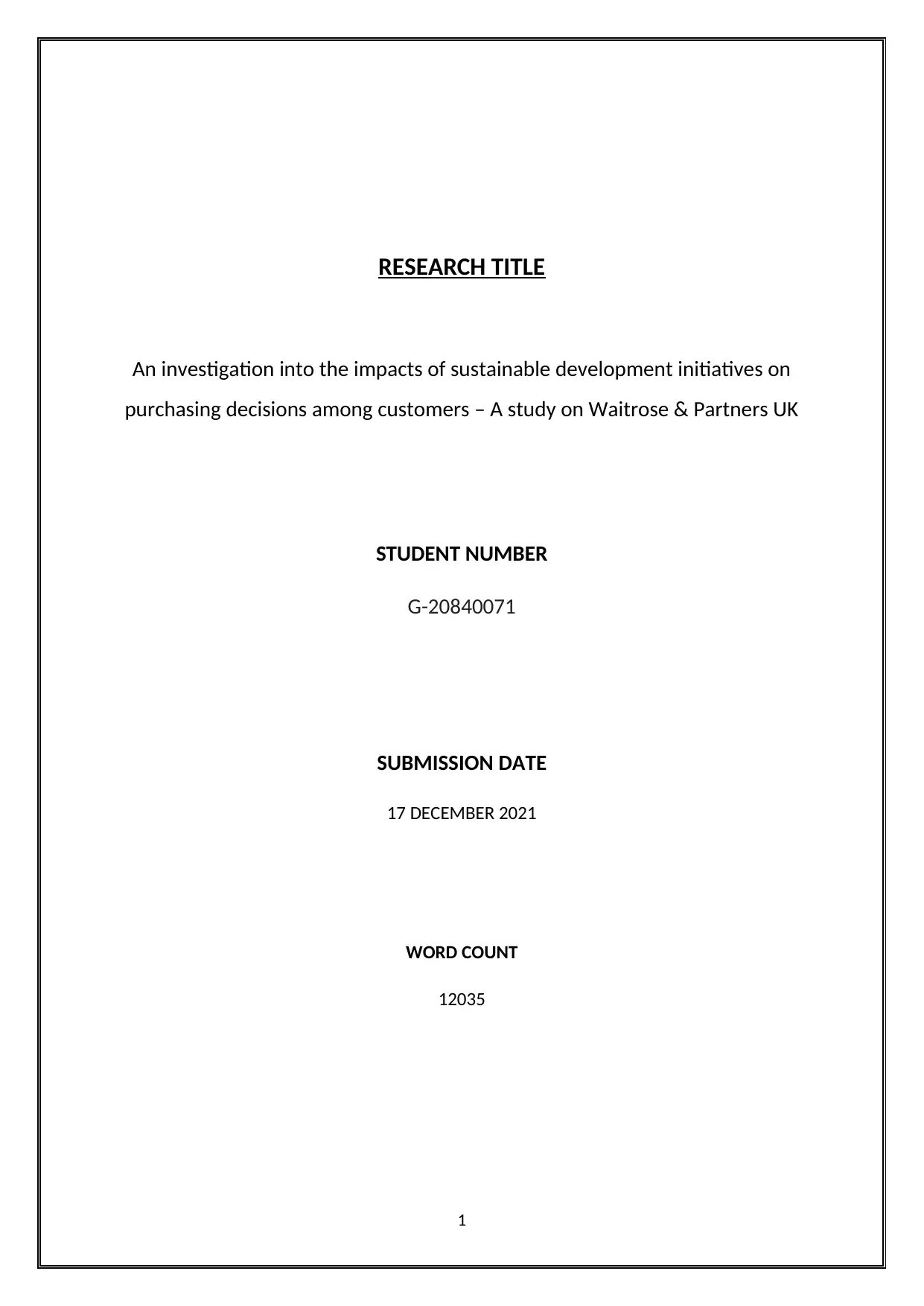
RESEARCH TITLE
An investigation into the impacts of sustainable development initiatives on
purchasing decisions among customers – A study on Waitrose & Partners UK
STUDENT NUMBER
G-20840071
SUBMISSION DATE
17 DECEMBER 2021
WORD COUNT
12035
1
An investigation into the impacts of sustainable development initiatives on
purchasing decisions among customers – A study on Waitrose & Partners UK
STUDENT NUMBER
G-20840071
SUBMISSION DATE
17 DECEMBER 2021
WORD COUNT
12035
1
Paraphrase This Document
Need a fresh take? Get an instant paraphrase of this document with our AI Paraphraser
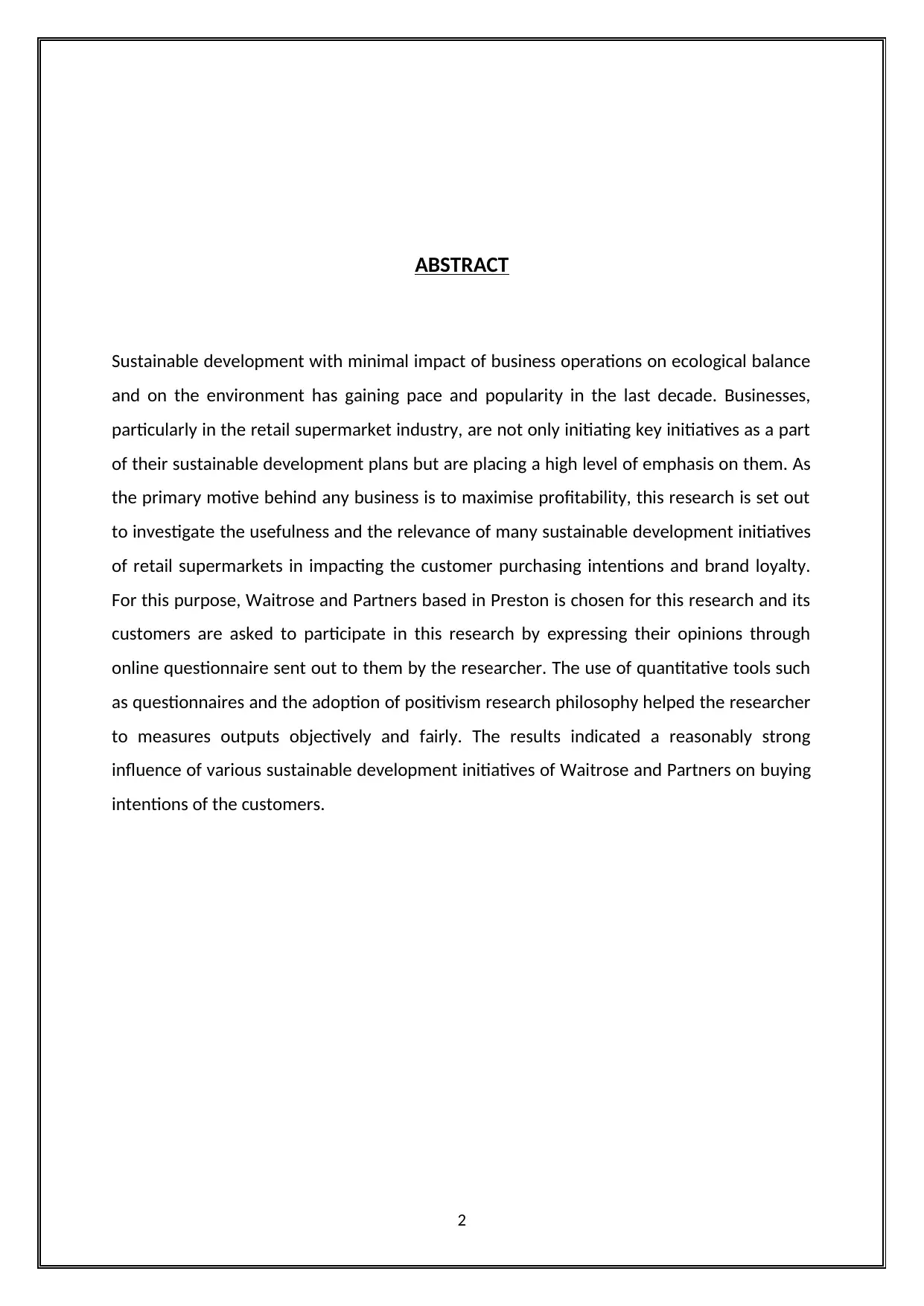
ABSTRACT
Sustainable development with minimal impact of business operations on ecological balance
and on the environment has gaining pace and popularity in the last decade. Businesses,
particularly in the retail supermarket industry, are not only initiating key initiatives as a part
of their sustainable development plans but are placing a high level of emphasis on them. As
the primary motive behind any business is to maximise profitability, this research is set out
to investigate the usefulness and the relevance of many sustainable development initiatives
of retail supermarkets in impacting the customer purchasing intentions and brand loyalty.
For this purpose, Waitrose and Partners based in Preston is chosen for this research and its
customers are asked to participate in this research by expressing their opinions through
online questionnaire sent out to them by the researcher. The use of quantitative tools such
as questionnaires and the adoption of positivism research philosophy helped the researcher
to measures outputs objectively and fairly. The results indicated a reasonably strong
influence of various sustainable development initiatives of Waitrose and Partners on buying
intentions of the customers.
2
Sustainable development with minimal impact of business operations on ecological balance
and on the environment has gaining pace and popularity in the last decade. Businesses,
particularly in the retail supermarket industry, are not only initiating key initiatives as a part
of their sustainable development plans but are placing a high level of emphasis on them. As
the primary motive behind any business is to maximise profitability, this research is set out
to investigate the usefulness and the relevance of many sustainable development initiatives
of retail supermarkets in impacting the customer purchasing intentions and brand loyalty.
For this purpose, Waitrose and Partners based in Preston is chosen for this research and its
customers are asked to participate in this research by expressing their opinions through
online questionnaire sent out to them by the researcher. The use of quantitative tools such
as questionnaires and the adoption of positivism research philosophy helped the researcher
to measures outputs objectively and fairly. The results indicated a reasonably strong
influence of various sustainable development initiatives of Waitrose and Partners on buying
intentions of the customers.
2
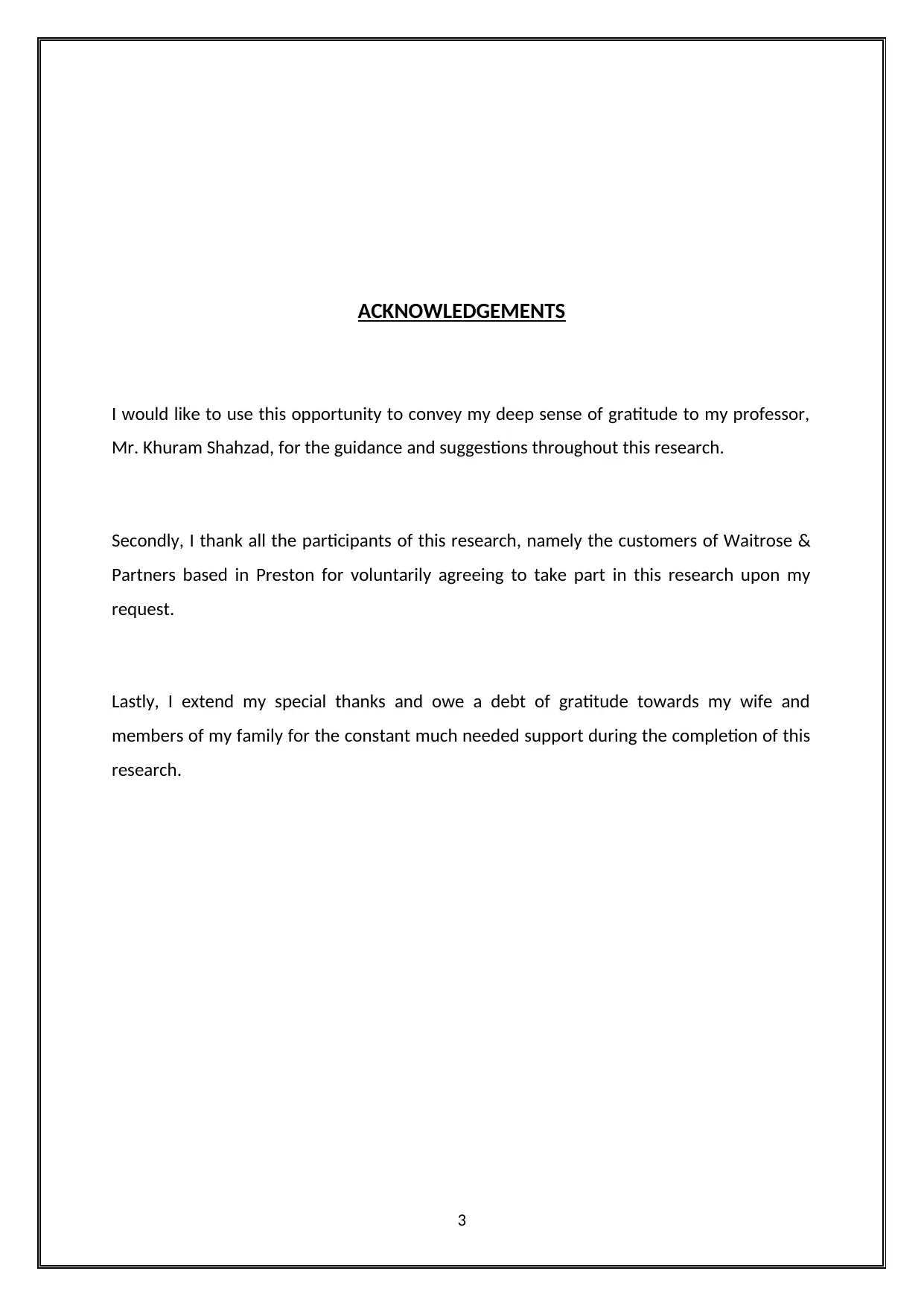
ACKNOWLEDGEMENTS
I would like to use this opportunity to convey my deep sense of gratitude to my professor,
Mr. Khuram Shahzad, for the guidance and suggestions throughout this research.
Secondly, I thank all the participants of this research, namely the customers of Waitrose &
Partners based in Preston for voluntarily agreeing to take part in this research upon my
request.
Lastly, I extend my special thanks and owe a debt of gratitude towards my wife and
members of my family for the constant much needed support during the completion of this
research.
3
I would like to use this opportunity to convey my deep sense of gratitude to my professor,
Mr. Khuram Shahzad, for the guidance and suggestions throughout this research.
Secondly, I thank all the participants of this research, namely the customers of Waitrose &
Partners based in Preston for voluntarily agreeing to take part in this research upon my
request.
Lastly, I extend my special thanks and owe a debt of gratitude towards my wife and
members of my family for the constant much needed support during the completion of this
research.
3
⊘ This is a preview!⊘
Do you want full access?
Subscribe today to unlock all pages.

Trusted by 1+ million students worldwide
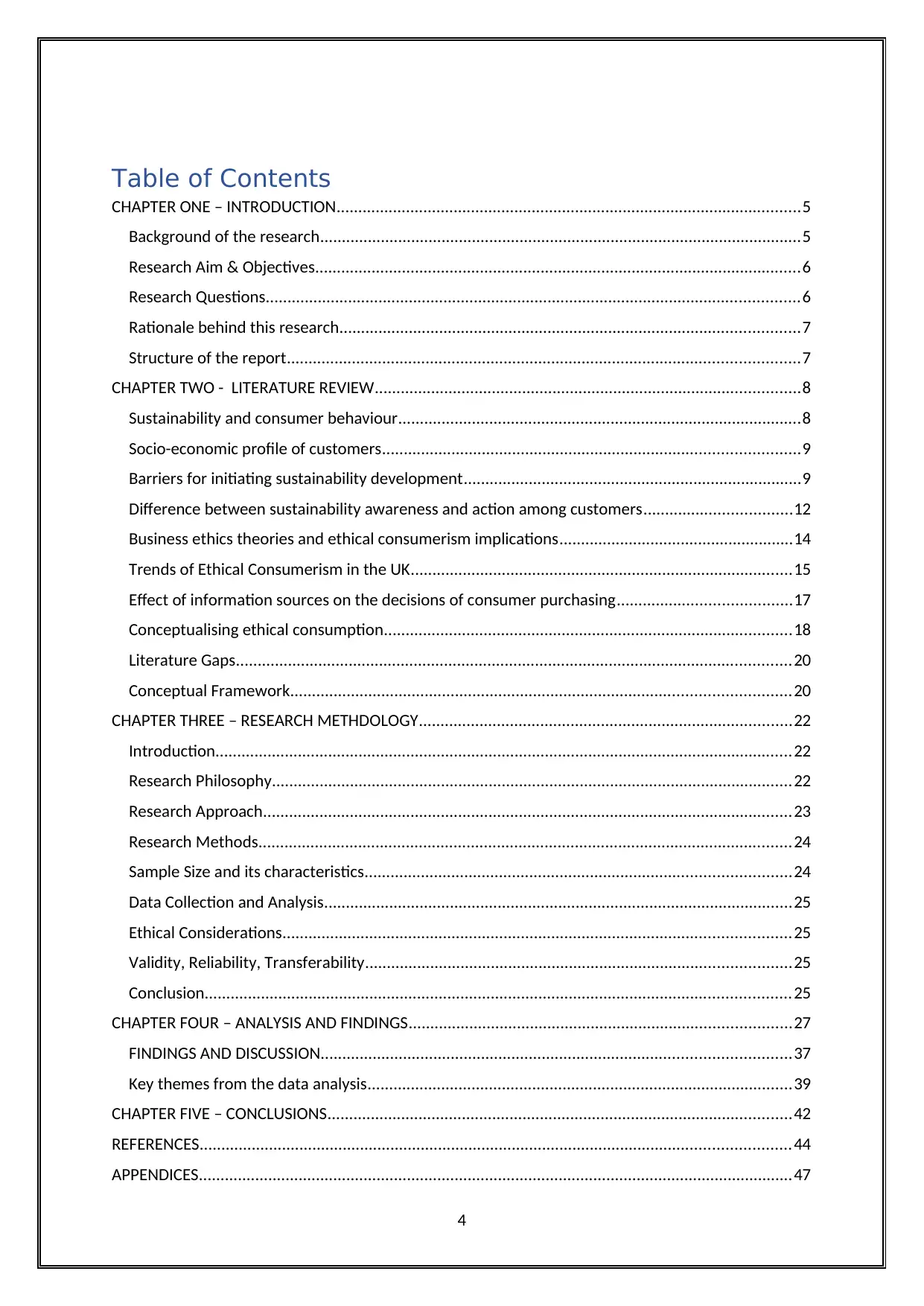
Table of Contents
CHAPTER ONE – INTRODUCTION...........................................................................................................5
Background of the research...............................................................................................................5
Research Aim & Objectives................................................................................................................6
Research Questions...........................................................................................................................6
Rationale behind this research..........................................................................................................7
Structure of the report......................................................................................................................7
CHAPTER TWO - LITERATURE REVIEW..................................................................................................8
Sustainability and consumer behaviour.............................................................................................8
Socio-economic profile of customers................................................................................................9
Barriers for initiating sustainability development..............................................................................9
Difference between sustainability awareness and action among customers..................................12
Business ethics theories and ethical consumerism implications......................................................14
Trends of Ethical Consumerism in the UK........................................................................................15
Effect of information sources on the decisions of consumer purchasing........................................17
Conceptualising ethical consumption..............................................................................................18
Literature Gaps................................................................................................................................20
Conceptual Framework...................................................................................................................20
CHAPTER THREE – RESEARCH METHDOLOGY......................................................................................22
Introduction.....................................................................................................................................22
Research Philosophy........................................................................................................................22
Research Approach..........................................................................................................................23
Research Methods...........................................................................................................................24
Sample Size and its characteristics..................................................................................................24
Data Collection and Analysis............................................................................................................25
Ethical Considerations.....................................................................................................................25
Validity, Reliability, Transferability..................................................................................................25
Conclusion.......................................................................................................................................25
CHAPTER FOUR – ANALYSIS AND FINDINGS........................................................................................27
FINDINGS AND DISCUSSION............................................................................................................37
Key themes from the data analysis..................................................................................................39
CHAPTER FIVE – CONCLUSIONS...........................................................................................................42
REFERENCES........................................................................................................................................44
APPENDICES.........................................................................................................................................47
4
CHAPTER ONE – INTRODUCTION...........................................................................................................5
Background of the research...............................................................................................................5
Research Aim & Objectives................................................................................................................6
Research Questions...........................................................................................................................6
Rationale behind this research..........................................................................................................7
Structure of the report......................................................................................................................7
CHAPTER TWO - LITERATURE REVIEW..................................................................................................8
Sustainability and consumer behaviour.............................................................................................8
Socio-economic profile of customers................................................................................................9
Barriers for initiating sustainability development..............................................................................9
Difference between sustainability awareness and action among customers..................................12
Business ethics theories and ethical consumerism implications......................................................14
Trends of Ethical Consumerism in the UK........................................................................................15
Effect of information sources on the decisions of consumer purchasing........................................17
Conceptualising ethical consumption..............................................................................................18
Literature Gaps................................................................................................................................20
Conceptual Framework...................................................................................................................20
CHAPTER THREE – RESEARCH METHDOLOGY......................................................................................22
Introduction.....................................................................................................................................22
Research Philosophy........................................................................................................................22
Research Approach..........................................................................................................................23
Research Methods...........................................................................................................................24
Sample Size and its characteristics..................................................................................................24
Data Collection and Analysis............................................................................................................25
Ethical Considerations.....................................................................................................................25
Validity, Reliability, Transferability..................................................................................................25
Conclusion.......................................................................................................................................25
CHAPTER FOUR – ANALYSIS AND FINDINGS........................................................................................27
FINDINGS AND DISCUSSION............................................................................................................37
Key themes from the data analysis..................................................................................................39
CHAPTER FIVE – CONCLUSIONS...........................................................................................................42
REFERENCES........................................................................................................................................44
APPENDICES.........................................................................................................................................47
4
Paraphrase This Document
Need a fresh take? Get an instant paraphrase of this document with our AI Paraphraser
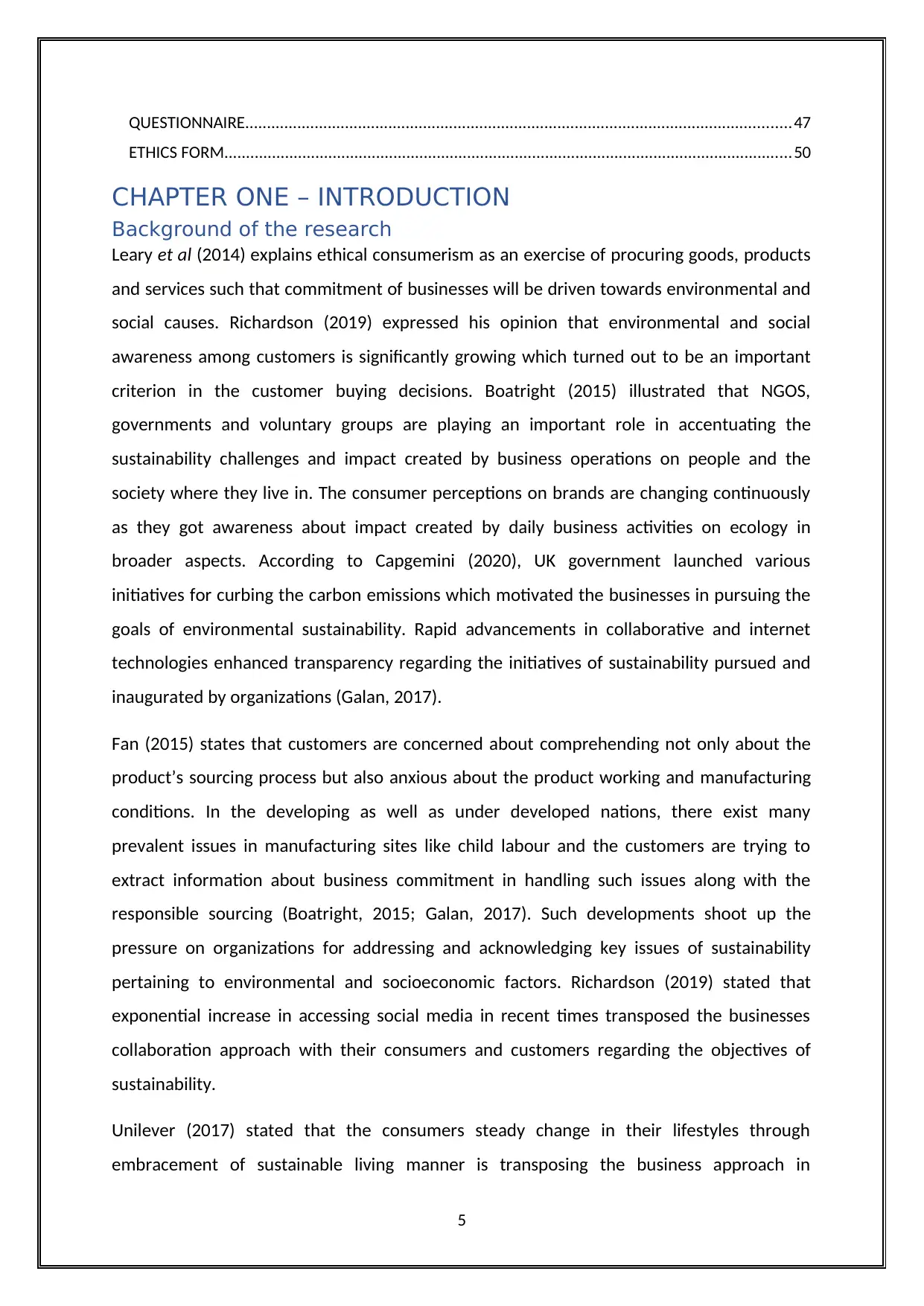
QUESTIONNAIRE..............................................................................................................................47
ETHICS FORM...................................................................................................................................50
CHAPTER ONE – INTRODUCTION
Background of the research
Leary et al (2014) explains ethical consumerism as an exercise of procuring goods, products
and services such that commitment of businesses will be driven towards environmental and
social causes. Richardson (2019) expressed his opinion that environmental and social
awareness among customers is significantly growing which turned out to be an important
criterion in the customer buying decisions. Boatright (2015) illustrated that NGOS,
governments and voluntary groups are playing an important role in accentuating the
sustainability challenges and impact created by business operations on people and the
society where they live in. The consumer perceptions on brands are changing continuously
as they got awareness about impact created by daily business activities on ecology in
broader aspects. According to Capgemini (2020), UK government launched various
initiatives for curbing the carbon emissions which motivated the businesses in pursuing the
goals of environmental sustainability. Rapid advancements in collaborative and internet
technologies enhanced transparency regarding the initiatives of sustainability pursued and
inaugurated by organizations (Galan, 2017).
Fan (2015) states that customers are concerned about comprehending not only about the
product’s sourcing process but also anxious about the product working and manufacturing
conditions. In the developing as well as under developed nations, there exist many
prevalent issues in manufacturing sites like child labour and the customers are trying to
extract information about business commitment in handling such issues along with the
responsible sourcing (Boatright, 2015; Galan, 2017). Such developments shoot up the
pressure on organizations for addressing and acknowledging key issues of sustainability
pertaining to environmental and socioeconomic factors. Richardson (2019) stated that
exponential increase in accessing social media in recent times transposed the businesses
collaboration approach with their consumers and customers regarding the objectives of
sustainability.
Unilever (2017) stated that the consumers steady change in their lifestyles through
embracement of sustainable living manner is transposing the business approach in
5
ETHICS FORM...................................................................................................................................50
CHAPTER ONE – INTRODUCTION
Background of the research
Leary et al (2014) explains ethical consumerism as an exercise of procuring goods, products
and services such that commitment of businesses will be driven towards environmental and
social causes. Richardson (2019) expressed his opinion that environmental and social
awareness among customers is significantly growing which turned out to be an important
criterion in the customer buying decisions. Boatright (2015) illustrated that NGOS,
governments and voluntary groups are playing an important role in accentuating the
sustainability challenges and impact created by business operations on people and the
society where they live in. The consumer perceptions on brands are changing continuously
as they got awareness about impact created by daily business activities on ecology in
broader aspects. According to Capgemini (2020), UK government launched various
initiatives for curbing the carbon emissions which motivated the businesses in pursuing the
goals of environmental sustainability. Rapid advancements in collaborative and internet
technologies enhanced transparency regarding the initiatives of sustainability pursued and
inaugurated by organizations (Galan, 2017).
Fan (2015) states that customers are concerned about comprehending not only about the
product’s sourcing process but also anxious about the product working and manufacturing
conditions. In the developing as well as under developed nations, there exist many
prevalent issues in manufacturing sites like child labour and the customers are trying to
extract information about business commitment in handling such issues along with the
responsible sourcing (Boatright, 2015; Galan, 2017). Such developments shoot up the
pressure on organizations for addressing and acknowledging key issues of sustainability
pertaining to environmental and socioeconomic factors. Richardson (2019) stated that
exponential increase in accessing social media in recent times transposed the businesses
collaboration approach with their consumers and customers regarding the objectives of
sustainability.
Unilever (2017) stated that the consumers steady change in their lifestyles through
embracement of sustainable living manner is transposing the business approach in
5
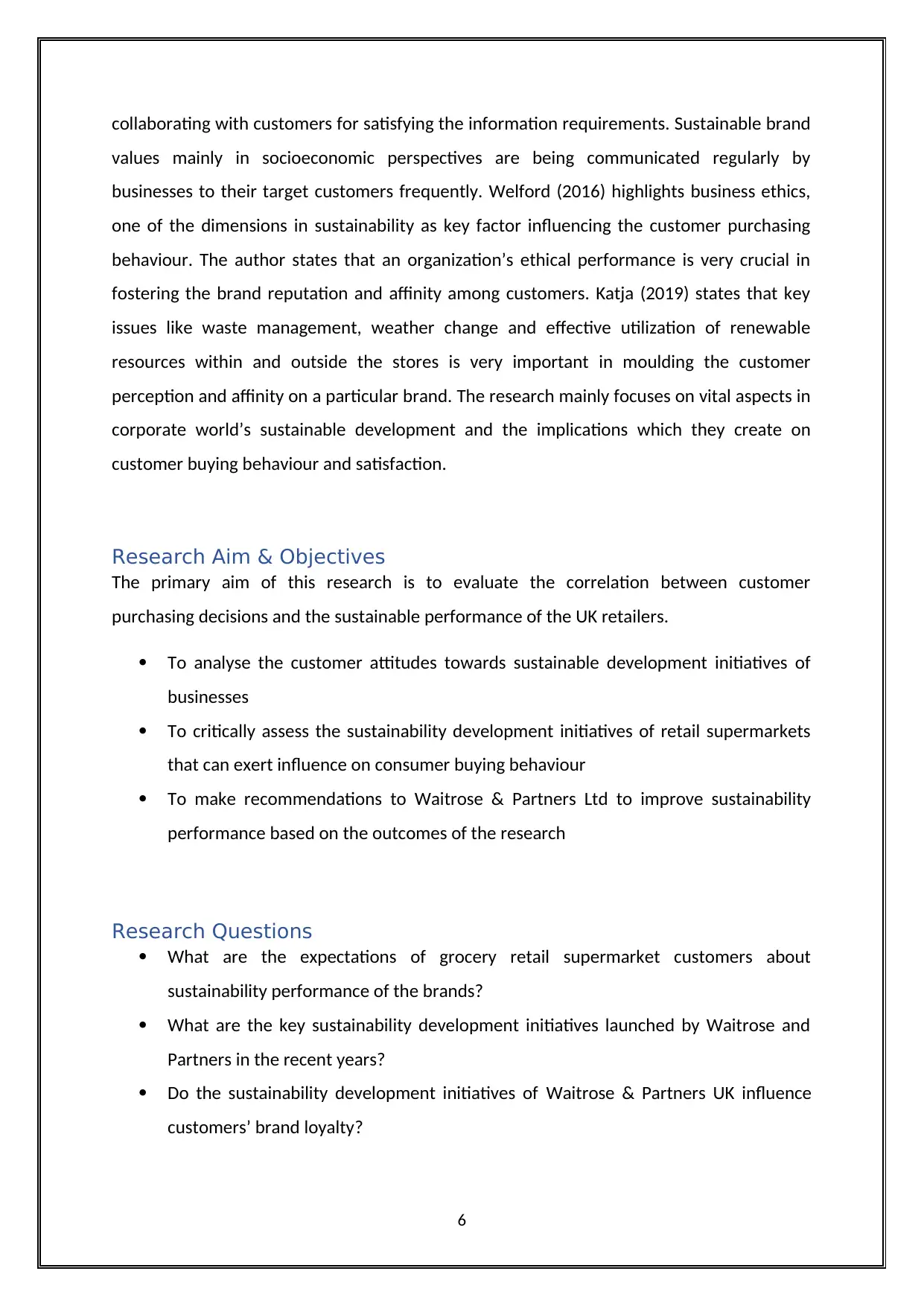
collaborating with customers for satisfying the information requirements. Sustainable brand
values mainly in socioeconomic perspectives are being communicated regularly by
businesses to their target customers frequently. Welford (2016) highlights business ethics,
one of the dimensions in sustainability as key factor influencing the customer purchasing
behaviour. The author states that an organization’s ethical performance is very crucial in
fostering the brand reputation and affinity among customers. Katja (2019) states that key
issues like waste management, weather change and effective utilization of renewable
resources within and outside the stores is very important in moulding the customer
perception and affinity on a particular brand. The research mainly focuses on vital aspects in
corporate world’s sustainable development and the implications which they create on
customer buying behaviour and satisfaction.
Research Aim & Objectives
The primary aim of this research is to evaluate the correlation between customer
purchasing decisions and the sustainable performance of the UK retailers.
To analyse the customer attitudes towards sustainable development initiatives of
businesses
To critically assess the sustainability development initiatives of retail supermarkets
that can exert influence on consumer buying behaviour
To make recommendations to Waitrose & Partners Ltd to improve sustainability
performance based on the outcomes of the research
Research Questions
What are the expectations of grocery retail supermarket customers about
sustainability performance of the brands?
What are the key sustainability development initiatives launched by Waitrose and
Partners in the recent years?
Do the sustainability development initiatives of Waitrose & Partners UK influence
customers’ brand loyalty?
6
values mainly in socioeconomic perspectives are being communicated regularly by
businesses to their target customers frequently. Welford (2016) highlights business ethics,
one of the dimensions in sustainability as key factor influencing the customer purchasing
behaviour. The author states that an organization’s ethical performance is very crucial in
fostering the brand reputation and affinity among customers. Katja (2019) states that key
issues like waste management, weather change and effective utilization of renewable
resources within and outside the stores is very important in moulding the customer
perception and affinity on a particular brand. The research mainly focuses on vital aspects in
corporate world’s sustainable development and the implications which they create on
customer buying behaviour and satisfaction.
Research Aim & Objectives
The primary aim of this research is to evaluate the correlation between customer
purchasing decisions and the sustainable performance of the UK retailers.
To analyse the customer attitudes towards sustainable development initiatives of
businesses
To critically assess the sustainability development initiatives of retail supermarkets
that can exert influence on consumer buying behaviour
To make recommendations to Waitrose & Partners Ltd to improve sustainability
performance based on the outcomes of the research
Research Questions
What are the expectations of grocery retail supermarket customers about
sustainability performance of the brands?
What are the key sustainability development initiatives launched by Waitrose and
Partners in the recent years?
Do the sustainability development initiatives of Waitrose & Partners UK influence
customers’ brand loyalty?
6
⊘ This is a preview!⊘
Do you want full access?
Subscribe today to unlock all pages.

Trusted by 1+ million students worldwide
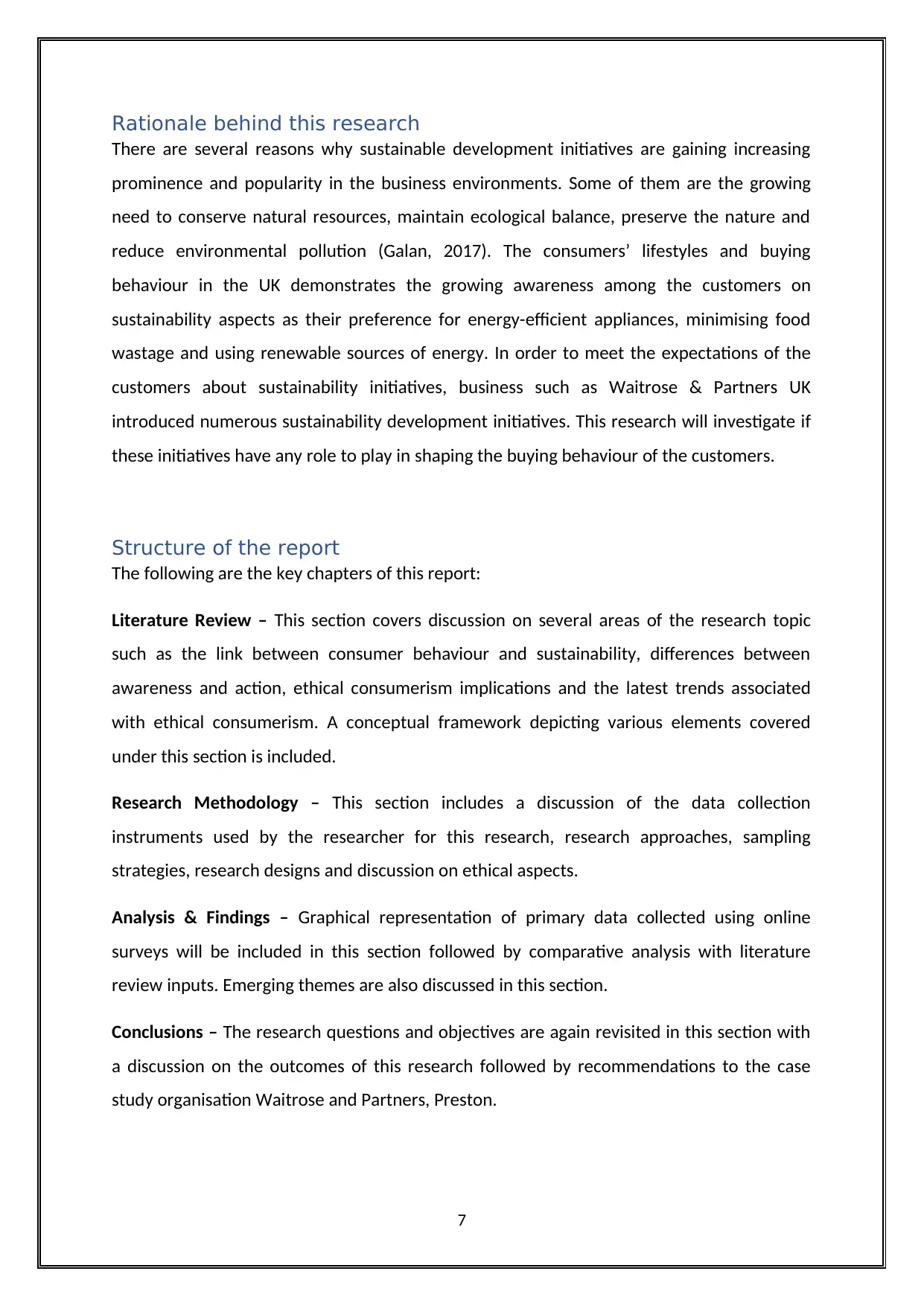
Rationale behind this research
There are several reasons why sustainable development initiatives are gaining increasing
prominence and popularity in the business environments. Some of them are the growing
need to conserve natural resources, maintain ecological balance, preserve the nature and
reduce environmental pollution (Galan, 2017). The consumers’ lifestyles and buying
behaviour in the UK demonstrates the growing awareness among the customers on
sustainability aspects as their preference for energy-efficient appliances, minimising food
wastage and using renewable sources of energy. In order to meet the expectations of the
customers about sustainability initiatives, business such as Waitrose & Partners UK
introduced numerous sustainability development initiatives. This research will investigate if
these initiatives have any role to play in shaping the buying behaviour of the customers.
Structure of the report
The following are the key chapters of this report:
Literature Review – This section covers discussion on several areas of the research topic
such as the link between consumer behaviour and sustainability, differences between
awareness and action, ethical consumerism implications and the latest trends associated
with ethical consumerism. A conceptual framework depicting various elements covered
under this section is included.
Research Methodology – This section includes a discussion of the data collection
instruments used by the researcher for this research, research approaches, sampling
strategies, research designs and discussion on ethical aspects.
Analysis & Findings – Graphical representation of primary data collected using online
surveys will be included in this section followed by comparative analysis with literature
review inputs. Emerging themes are also discussed in this section.
Conclusions – The research questions and objectives are again revisited in this section with
a discussion on the outcomes of this research followed by recommendations to the case
study organisation Waitrose and Partners, Preston.
7
There are several reasons why sustainable development initiatives are gaining increasing
prominence and popularity in the business environments. Some of them are the growing
need to conserve natural resources, maintain ecological balance, preserve the nature and
reduce environmental pollution (Galan, 2017). The consumers’ lifestyles and buying
behaviour in the UK demonstrates the growing awareness among the customers on
sustainability aspects as their preference for energy-efficient appliances, minimising food
wastage and using renewable sources of energy. In order to meet the expectations of the
customers about sustainability initiatives, business such as Waitrose & Partners UK
introduced numerous sustainability development initiatives. This research will investigate if
these initiatives have any role to play in shaping the buying behaviour of the customers.
Structure of the report
The following are the key chapters of this report:
Literature Review – This section covers discussion on several areas of the research topic
such as the link between consumer behaviour and sustainability, differences between
awareness and action, ethical consumerism implications and the latest trends associated
with ethical consumerism. A conceptual framework depicting various elements covered
under this section is included.
Research Methodology – This section includes a discussion of the data collection
instruments used by the researcher for this research, research approaches, sampling
strategies, research designs and discussion on ethical aspects.
Analysis & Findings – Graphical representation of primary data collected using online
surveys will be included in this section followed by comparative analysis with literature
review inputs. Emerging themes are also discussed in this section.
Conclusions – The research questions and objectives are again revisited in this section with
a discussion on the outcomes of this research followed by recommendations to the case
study organisation Waitrose and Partners, Preston.
7
Paraphrase This Document
Need a fresh take? Get an instant paraphrase of this document with our AI Paraphraser
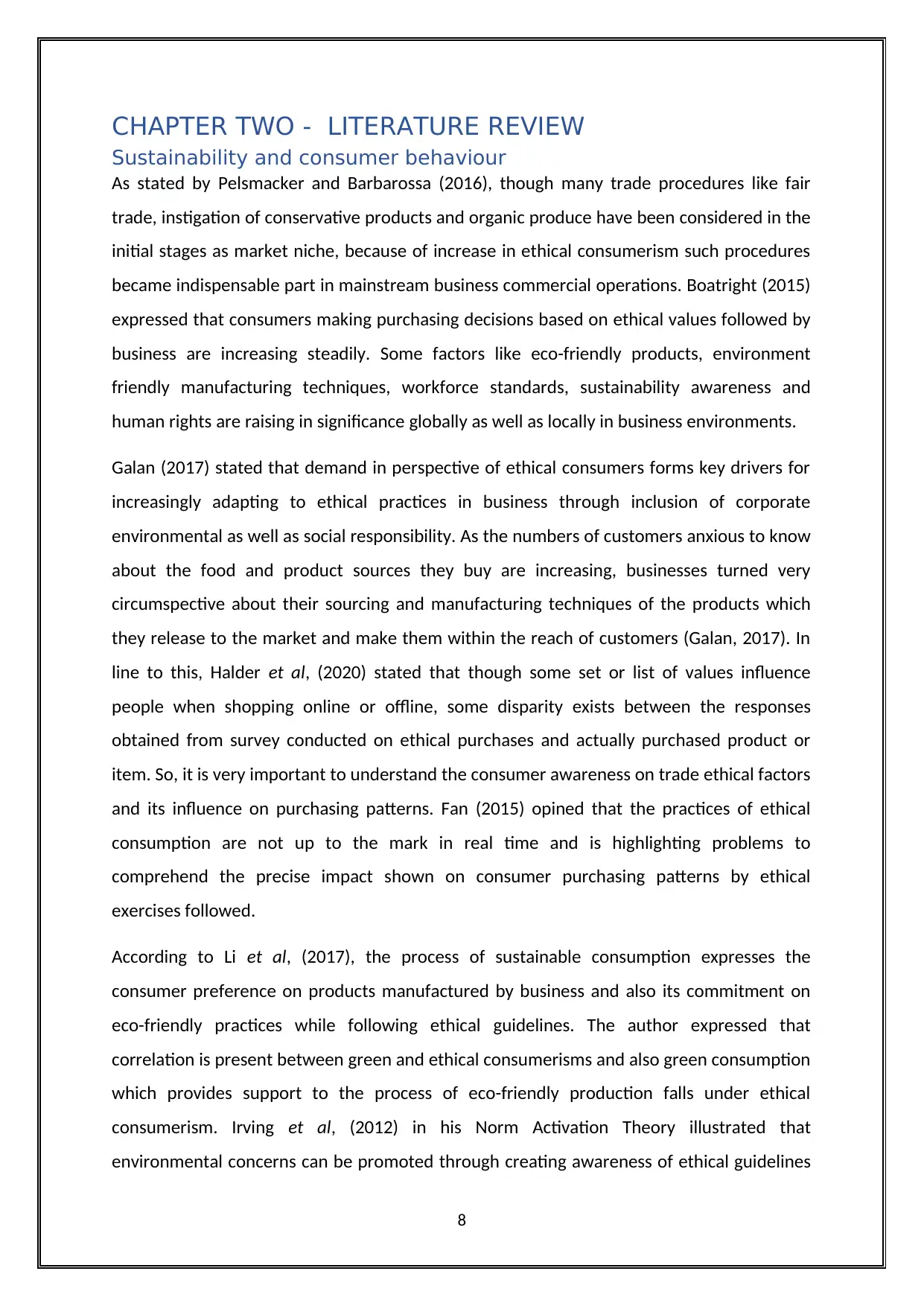
CHAPTER TWO - LITERATURE REVIEW
Sustainability and consumer behaviour
As stated by Pelsmacker and Barbarossa (2016), though many trade procedures like fair
trade, instigation of conservative products and organic produce have been considered in the
initial stages as market niche, because of increase in ethical consumerism such procedures
became indispensable part in mainstream business commercial operations. Boatright (2015)
expressed that consumers making purchasing decisions based on ethical values followed by
business are increasing steadily. Some factors like eco-friendly products, environment
friendly manufacturing techniques, workforce standards, sustainability awareness and
human rights are raising in significance globally as well as locally in business environments.
Galan (2017) stated that demand in perspective of ethical consumers forms key drivers for
increasingly adapting to ethical practices in business through inclusion of corporate
environmental as well as social responsibility. As the numbers of customers anxious to know
about the food and product sources they buy are increasing, businesses turned very
circumspective about their sourcing and manufacturing techniques of the products which
they release to the market and make them within the reach of customers (Galan, 2017). In
line to this, Halder et al, (2020) stated that though some set or list of values influence
people when shopping online or offline, some disparity exists between the responses
obtained from survey conducted on ethical purchases and actually purchased product or
item. So, it is very important to understand the consumer awareness on trade ethical factors
and its influence on purchasing patterns. Fan (2015) opined that the practices of ethical
consumption are not up to the mark in real time and is highlighting problems to
comprehend the precise impact shown on consumer purchasing patterns by ethical
exercises followed.
According to Li et al, (2017), the process of sustainable consumption expresses the
consumer preference on products manufactured by business and also its commitment on
eco-friendly practices while following ethical guidelines. The author expressed that
correlation is present between green and ethical consumerisms and also green consumption
which provides support to the process of eco-friendly production falls under ethical
consumerism. Irving et al, (2012) in his Norm Activation Theory illustrated that
environmental concerns can be promoted through creating awareness of ethical guidelines
8
Sustainability and consumer behaviour
As stated by Pelsmacker and Barbarossa (2016), though many trade procedures like fair
trade, instigation of conservative products and organic produce have been considered in the
initial stages as market niche, because of increase in ethical consumerism such procedures
became indispensable part in mainstream business commercial operations. Boatright (2015)
expressed that consumers making purchasing decisions based on ethical values followed by
business are increasing steadily. Some factors like eco-friendly products, environment
friendly manufacturing techniques, workforce standards, sustainability awareness and
human rights are raising in significance globally as well as locally in business environments.
Galan (2017) stated that demand in perspective of ethical consumers forms key drivers for
increasingly adapting to ethical practices in business through inclusion of corporate
environmental as well as social responsibility. As the numbers of customers anxious to know
about the food and product sources they buy are increasing, businesses turned very
circumspective about their sourcing and manufacturing techniques of the products which
they release to the market and make them within the reach of customers (Galan, 2017). In
line to this, Halder et al, (2020) stated that though some set or list of values influence
people when shopping online or offline, some disparity exists between the responses
obtained from survey conducted on ethical purchases and actually purchased product or
item. So, it is very important to understand the consumer awareness on trade ethical factors
and its influence on purchasing patterns. Fan (2015) opined that the practices of ethical
consumption are not up to the mark in real time and is highlighting problems to
comprehend the precise impact shown on consumer purchasing patterns by ethical
exercises followed.
According to Li et al, (2017), the process of sustainable consumption expresses the
consumer preference on products manufactured by business and also its commitment on
eco-friendly practices while following ethical guidelines. The author expressed that
correlation is present between green and ethical consumerisms and also green consumption
which provides support to the process of eco-friendly production falls under ethical
consumerism. Irving et al, (2012) in his Norm Activation Theory illustrated that
environmental concerns can be promoted through creating awareness of ethical guidelines
8
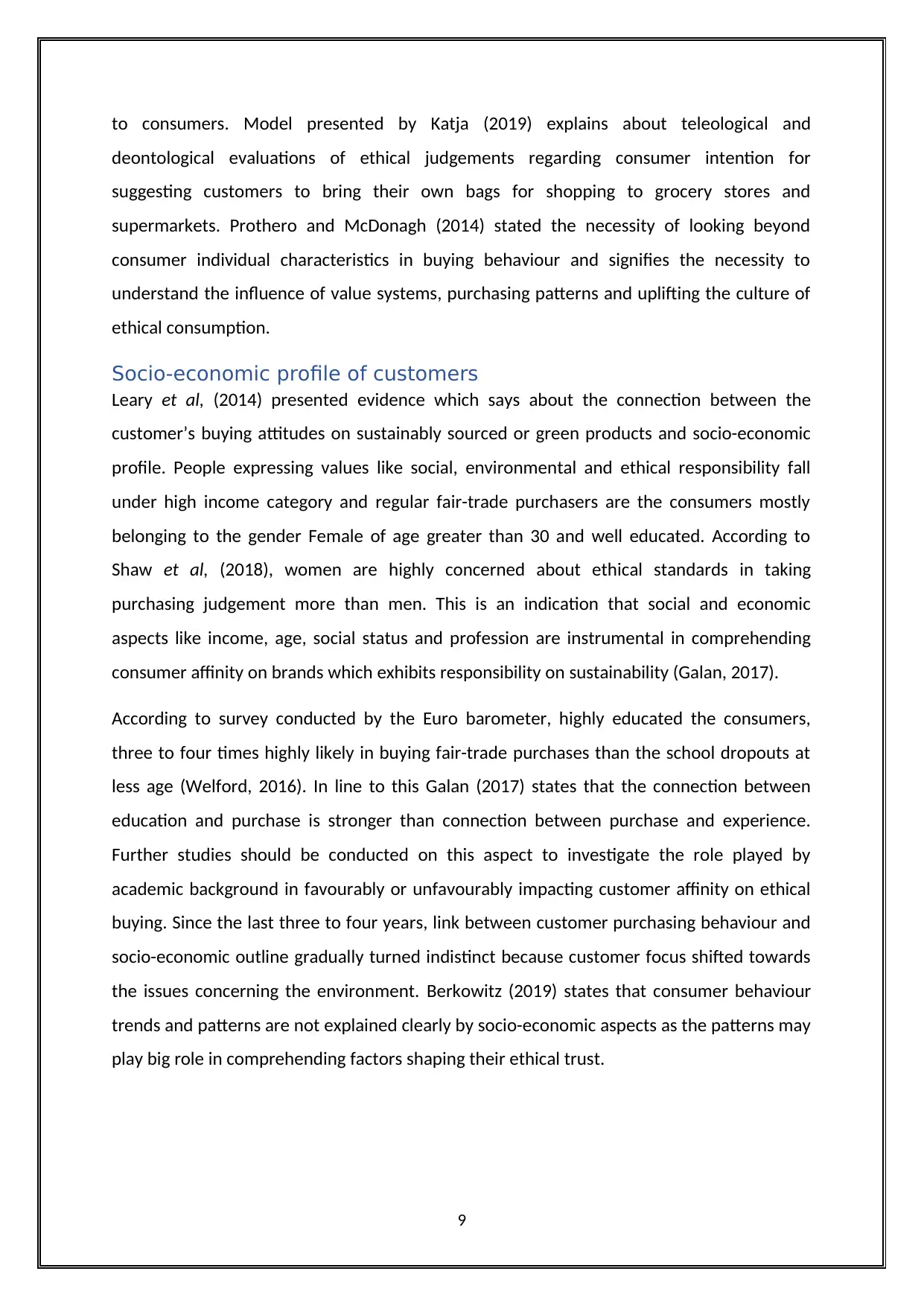
to consumers. Model presented by Katja (2019) explains about teleological and
deontological evaluations of ethical judgements regarding consumer intention for
suggesting customers to bring their own bags for shopping to grocery stores and
supermarkets. Prothero and McDonagh (2014) stated the necessity of looking beyond
consumer individual characteristics in buying behaviour and signifies the necessity to
understand the influence of value systems, purchasing patterns and uplifting the culture of
ethical consumption.
Socio-economic profile of customers
Leary et al, (2014) presented evidence which says about the connection between the
customer’s buying attitudes on sustainably sourced or green products and socio-economic
profile. People expressing values like social, environmental and ethical responsibility fall
under high income category and regular fair-trade purchasers are the consumers mostly
belonging to the gender Female of age greater than 30 and well educated. According to
Shaw et al, (2018), women are highly concerned about ethical standards in taking
purchasing judgement more than men. This is an indication that social and economic
aspects like income, age, social status and profession are instrumental in comprehending
consumer affinity on brands which exhibits responsibility on sustainability (Galan, 2017).
According to survey conducted by the Euro barometer, highly educated the consumers,
three to four times highly likely in buying fair-trade purchases than the school dropouts at
less age (Welford, 2016). In line to this Galan (2017) states that the connection between
education and purchase is stronger than connection between purchase and experience.
Further studies should be conducted on this aspect to investigate the role played by
academic background in favourably or unfavourably impacting customer affinity on ethical
buying. Since the last three to four years, link between customer purchasing behaviour and
socio-economic outline gradually turned indistinct because customer focus shifted towards
the issues concerning the environment. Berkowitz (2019) states that consumer behaviour
trends and patterns are not explained clearly by socio-economic aspects as the patterns may
play big role in comprehending factors shaping their ethical trust.
9
deontological evaluations of ethical judgements regarding consumer intention for
suggesting customers to bring their own bags for shopping to grocery stores and
supermarkets. Prothero and McDonagh (2014) stated the necessity of looking beyond
consumer individual characteristics in buying behaviour and signifies the necessity to
understand the influence of value systems, purchasing patterns and uplifting the culture of
ethical consumption.
Socio-economic profile of customers
Leary et al, (2014) presented evidence which says about the connection between the
customer’s buying attitudes on sustainably sourced or green products and socio-economic
profile. People expressing values like social, environmental and ethical responsibility fall
under high income category and regular fair-trade purchasers are the consumers mostly
belonging to the gender Female of age greater than 30 and well educated. According to
Shaw et al, (2018), women are highly concerned about ethical standards in taking
purchasing judgement more than men. This is an indication that social and economic
aspects like income, age, social status and profession are instrumental in comprehending
consumer affinity on brands which exhibits responsibility on sustainability (Galan, 2017).
According to survey conducted by the Euro barometer, highly educated the consumers,
three to four times highly likely in buying fair-trade purchases than the school dropouts at
less age (Welford, 2016). In line to this Galan (2017) states that the connection between
education and purchase is stronger than connection between purchase and experience.
Further studies should be conducted on this aspect to investigate the role played by
academic background in favourably or unfavourably impacting customer affinity on ethical
buying. Since the last three to four years, link between customer purchasing behaviour and
socio-economic outline gradually turned indistinct because customer focus shifted towards
the issues concerning the environment. Berkowitz (2019) states that consumer behaviour
trends and patterns are not explained clearly by socio-economic aspects as the patterns may
play big role in comprehending factors shaping their ethical trust.
9
⊘ This is a preview!⊘
Do you want full access?
Subscribe today to unlock all pages.

Trusted by 1+ million students worldwide
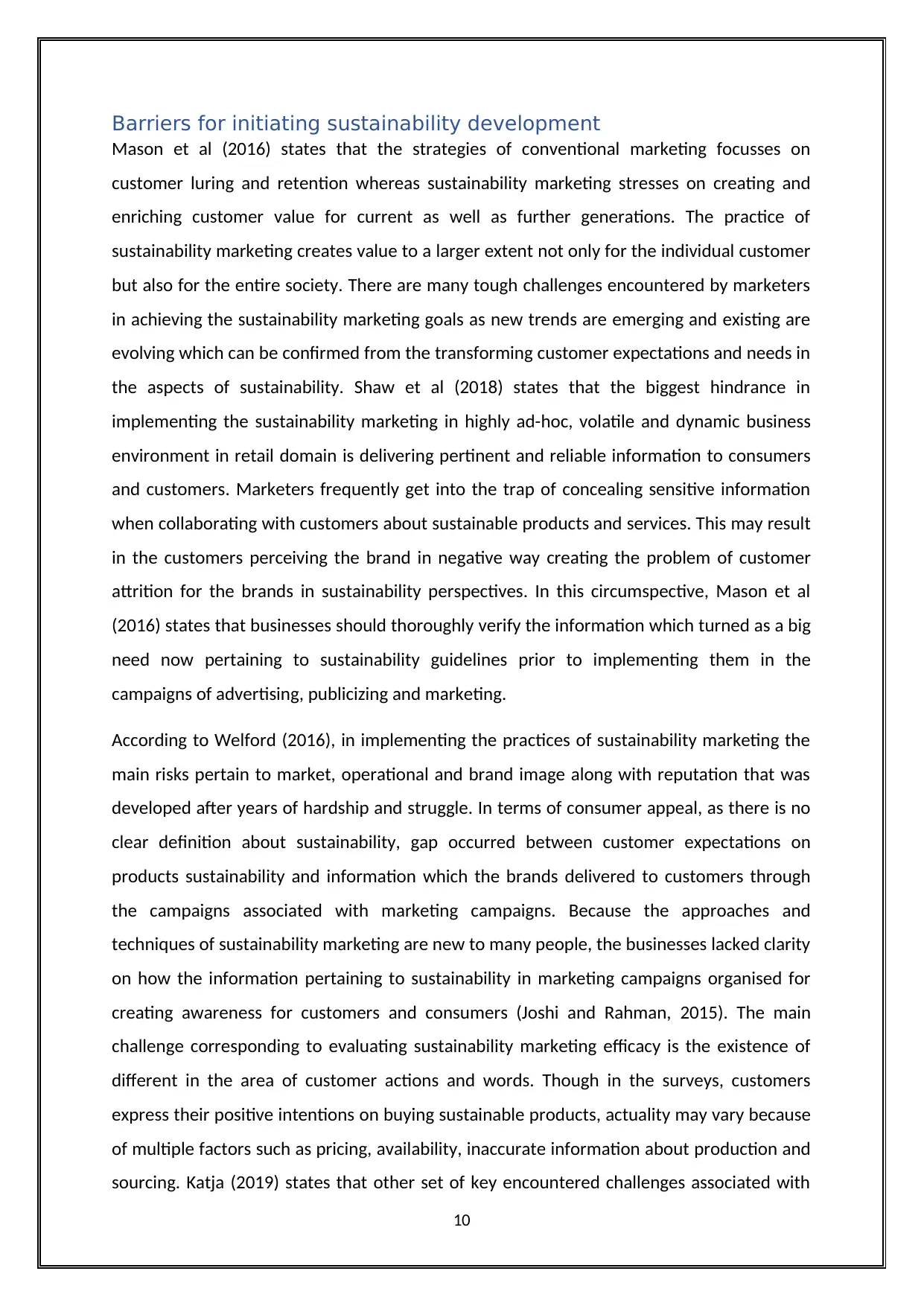
Barriers for initiating sustainability development
Mason et al (2016) states that the strategies of conventional marketing focusses on
customer luring and retention whereas sustainability marketing stresses on creating and
enriching customer value for current as well as further generations. The practice of
sustainability marketing creates value to a larger extent not only for the individual customer
but also for the entire society. There are many tough challenges encountered by marketers
in achieving the sustainability marketing goals as new trends are emerging and existing are
evolving which can be confirmed from the transforming customer expectations and needs in
the aspects of sustainability. Shaw et al (2018) states that the biggest hindrance in
implementing the sustainability marketing in highly ad-hoc, volatile and dynamic business
environment in retail domain is delivering pertinent and reliable information to consumers
and customers. Marketers frequently get into the trap of concealing sensitive information
when collaborating with customers about sustainable products and services. This may result
in the customers perceiving the brand in negative way creating the problem of customer
attrition for the brands in sustainability perspectives. In this circumspective, Mason et al
(2016) states that businesses should thoroughly verify the information which turned as a big
need now pertaining to sustainability guidelines prior to implementing them in the
campaigns of advertising, publicizing and marketing.
According to Welford (2016), in implementing the practices of sustainability marketing the
main risks pertain to market, operational and brand image along with reputation that was
developed after years of hardship and struggle. In terms of consumer appeal, as there is no
clear definition about sustainability, gap occurred between customer expectations on
products sustainability and information which the brands delivered to customers through
the campaigns associated with marketing campaigns. Because the approaches and
techniques of sustainability marketing are new to many people, the businesses lacked clarity
on how the information pertaining to sustainability in marketing campaigns organised for
creating awareness for customers and consumers (Joshi and Rahman, 2015). The main
challenge corresponding to evaluating sustainability marketing efficacy is the existence of
different in the area of customer actions and words. Though in the surveys, customers
express their positive intentions on buying sustainable products, actuality may vary because
of multiple factors such as pricing, availability, inaccurate information about production and
sourcing. Katja (2019) states that other set of key encountered challenges associated with
10
Mason et al (2016) states that the strategies of conventional marketing focusses on
customer luring and retention whereas sustainability marketing stresses on creating and
enriching customer value for current as well as further generations. The practice of
sustainability marketing creates value to a larger extent not only for the individual customer
but also for the entire society. There are many tough challenges encountered by marketers
in achieving the sustainability marketing goals as new trends are emerging and existing are
evolving which can be confirmed from the transforming customer expectations and needs in
the aspects of sustainability. Shaw et al (2018) states that the biggest hindrance in
implementing the sustainability marketing in highly ad-hoc, volatile and dynamic business
environment in retail domain is delivering pertinent and reliable information to consumers
and customers. Marketers frequently get into the trap of concealing sensitive information
when collaborating with customers about sustainable products and services. This may result
in the customers perceiving the brand in negative way creating the problem of customer
attrition for the brands in sustainability perspectives. In this circumspective, Mason et al
(2016) states that businesses should thoroughly verify the information which turned as a big
need now pertaining to sustainability guidelines prior to implementing them in the
campaigns of advertising, publicizing and marketing.
According to Welford (2016), in implementing the practices of sustainability marketing the
main risks pertain to market, operational and brand image along with reputation that was
developed after years of hardship and struggle. In terms of consumer appeal, as there is no
clear definition about sustainability, gap occurred between customer expectations on
products sustainability and information which the brands delivered to customers through
the campaigns associated with marketing campaigns. Because the approaches and
techniques of sustainability marketing are new to many people, the businesses lacked clarity
on how the information pertaining to sustainability in marketing campaigns organised for
creating awareness for customers and consumers (Joshi and Rahman, 2015). The main
challenge corresponding to evaluating sustainability marketing efficacy is the existence of
different in the area of customer actions and words. Though in the surveys, customers
express their positive intentions on buying sustainable products, actuality may vary because
of multiple factors such as pricing, availability, inaccurate information about production and
sourcing. Katja (2019) states that other set of key encountered challenges associated with
10
Paraphrase This Document
Need a fresh take? Get an instant paraphrase of this document with our AI Paraphraser
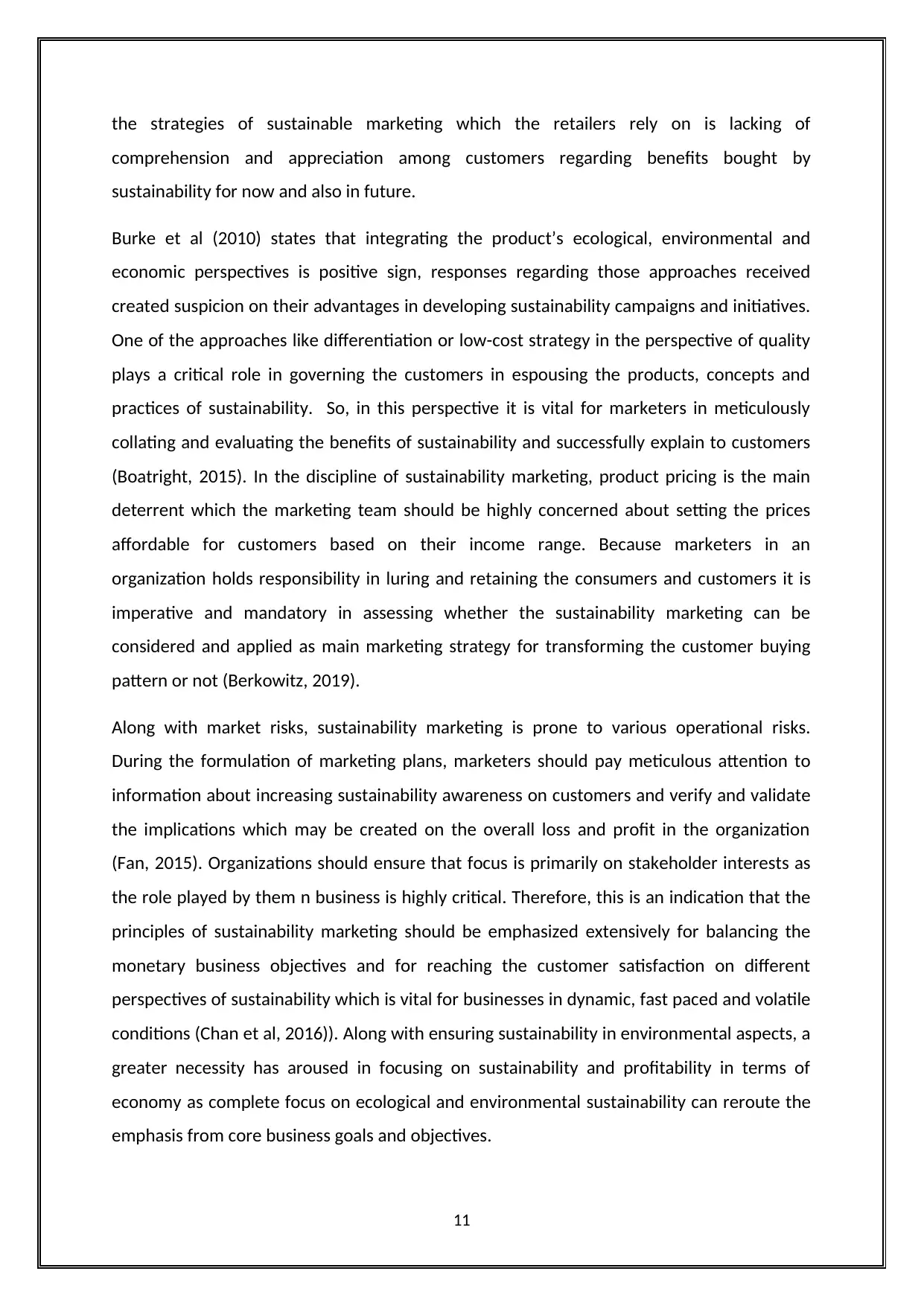
the strategies of sustainable marketing which the retailers rely on is lacking of
comprehension and appreciation among customers regarding benefits bought by
sustainability for now and also in future.
Burke et al (2010) states that integrating the product’s ecological, environmental and
economic perspectives is positive sign, responses regarding those approaches received
created suspicion on their advantages in developing sustainability campaigns and initiatives.
One of the approaches like differentiation or low-cost strategy in the perspective of quality
plays a critical role in governing the customers in espousing the products, concepts and
practices of sustainability. So, in this perspective it is vital for marketers in meticulously
collating and evaluating the benefits of sustainability and successfully explain to customers
(Boatright, 2015). In the discipline of sustainability marketing, product pricing is the main
deterrent which the marketing team should be highly concerned about setting the prices
affordable for customers based on their income range. Because marketers in an
organization holds responsibility in luring and retaining the consumers and customers it is
imperative and mandatory in assessing whether the sustainability marketing can be
considered and applied as main marketing strategy for transforming the customer buying
pattern or not (Berkowitz, 2019).
Along with market risks, sustainability marketing is prone to various operational risks.
During the formulation of marketing plans, marketers should pay meticulous attention to
information about increasing sustainability awareness on customers and verify and validate
the implications which may be created on the overall loss and profit in the organization
(Fan, 2015). Organizations should ensure that focus is primarily on stakeholder interests as
the role played by them n business is highly critical. Therefore, this is an indication that the
principles of sustainability marketing should be emphasized extensively for balancing the
monetary business objectives and for reaching the customer satisfaction on different
perspectives of sustainability which is vital for businesses in dynamic, fast paced and volatile
conditions (Chan et al, 2016)). Along with ensuring sustainability in environmental aspects, a
greater necessity has aroused in focusing on sustainability and profitability in terms of
economy as complete focus on ecological and environmental sustainability can reroute the
emphasis from core business goals and objectives.
11
comprehension and appreciation among customers regarding benefits bought by
sustainability for now and also in future.
Burke et al (2010) states that integrating the product’s ecological, environmental and
economic perspectives is positive sign, responses regarding those approaches received
created suspicion on their advantages in developing sustainability campaigns and initiatives.
One of the approaches like differentiation or low-cost strategy in the perspective of quality
plays a critical role in governing the customers in espousing the products, concepts and
practices of sustainability. So, in this perspective it is vital for marketers in meticulously
collating and evaluating the benefits of sustainability and successfully explain to customers
(Boatright, 2015). In the discipline of sustainability marketing, product pricing is the main
deterrent which the marketing team should be highly concerned about setting the prices
affordable for customers based on their income range. Because marketers in an
organization holds responsibility in luring and retaining the consumers and customers it is
imperative and mandatory in assessing whether the sustainability marketing can be
considered and applied as main marketing strategy for transforming the customer buying
pattern or not (Berkowitz, 2019).
Along with market risks, sustainability marketing is prone to various operational risks.
During the formulation of marketing plans, marketers should pay meticulous attention to
information about increasing sustainability awareness on customers and verify and validate
the implications which may be created on the overall loss and profit in the organization
(Fan, 2015). Organizations should ensure that focus is primarily on stakeholder interests as
the role played by them n business is highly critical. Therefore, this is an indication that the
principles of sustainability marketing should be emphasized extensively for balancing the
monetary business objectives and for reaching the customer satisfaction on different
perspectives of sustainability which is vital for businesses in dynamic, fast paced and volatile
conditions (Chan et al, 2016)). Along with ensuring sustainability in environmental aspects, a
greater necessity has aroused in focusing on sustainability and profitability in terms of
economy as complete focus on ecological and environmental sustainability can reroute the
emphasis from core business goals and objectives.
11
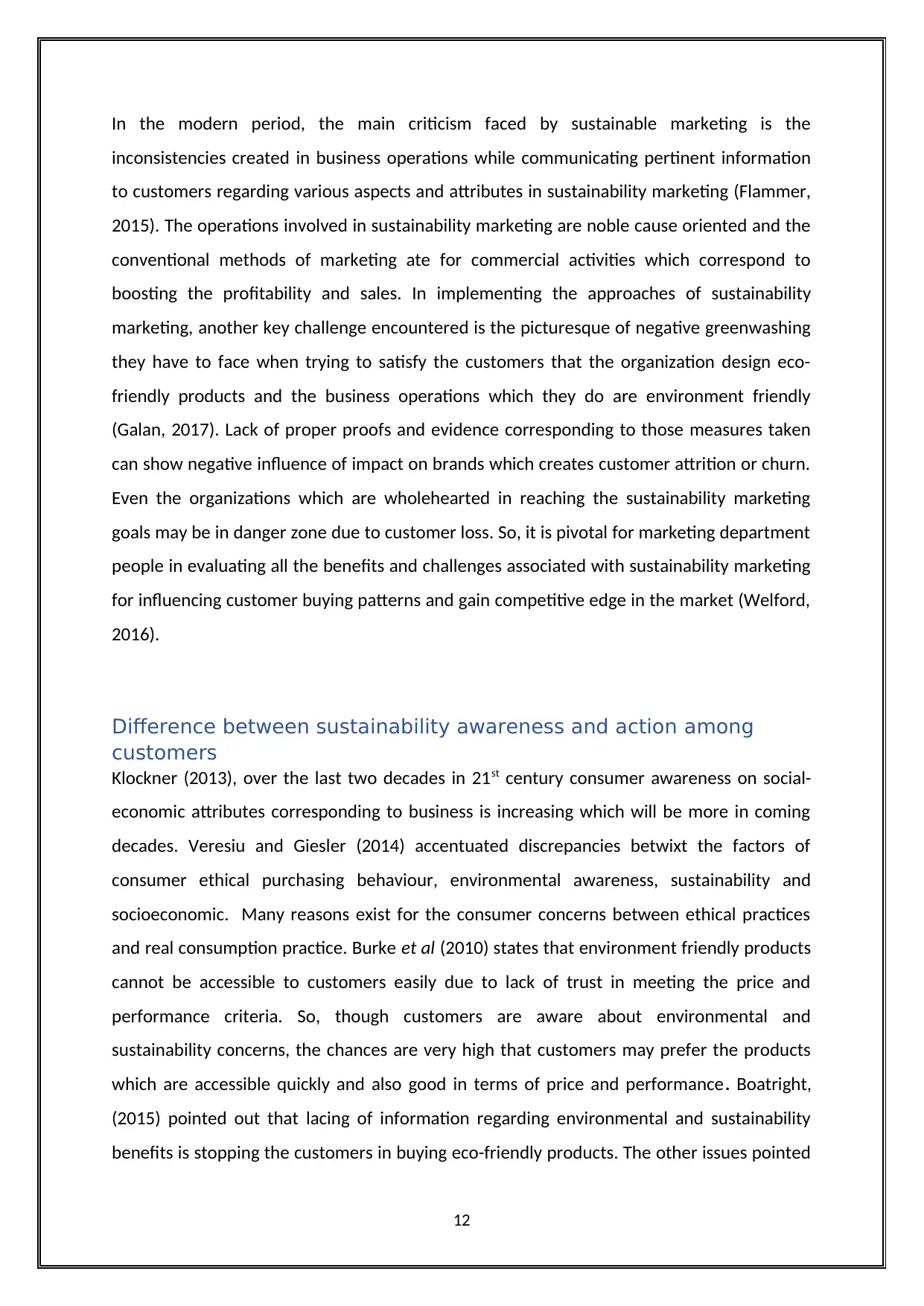
In the modern period, the main criticism faced by sustainable marketing is the
inconsistencies created in business operations while communicating pertinent information
to customers regarding various aspects and attributes in sustainability marketing (Flammer,
2015). The operations involved in sustainability marketing are noble cause oriented and the
conventional methods of marketing ate for commercial activities which correspond to
boosting the profitability and sales. In implementing the approaches of sustainability
marketing, another key challenge encountered is the picturesque of negative greenwashing
they have to face when trying to satisfy the customers that the organization design eco-
friendly products and the business operations which they do are environment friendly
(Galan, 2017). Lack of proper proofs and evidence corresponding to those measures taken
can show negative influence of impact on brands which creates customer attrition or churn.
Even the organizations which are wholehearted in reaching the sustainability marketing
goals may be in danger zone due to customer loss. So, it is pivotal for marketing department
people in evaluating all the benefits and challenges associated with sustainability marketing
for influencing customer buying patterns and gain competitive edge in the market (Welford,
2016).
Difference between sustainability awareness and action among
customers
Klockner (2013), over the last two decades in 21st century consumer awareness on social-
economic attributes corresponding to business is increasing which will be more in coming
decades. Veresiu and Giesler (2014) accentuated discrepancies betwixt the factors of
consumer ethical purchasing behaviour, environmental awareness, sustainability and
socioeconomic. Many reasons exist for the consumer concerns between ethical practices
and real consumption practice. Burke et al (2010) states that environment friendly products
cannot be accessible to customers easily due to lack of trust in meeting the price and
performance criteria. So, though customers are aware about environmental and
sustainability concerns, the chances are very high that customers may prefer the products
which are accessible quickly and also good in terms of price and performance. Boatright,
(2015) pointed out that lacing of information regarding environmental and sustainability
benefits is stopping the customers in buying eco-friendly products. The other issues pointed
12
inconsistencies created in business operations while communicating pertinent information
to customers regarding various aspects and attributes in sustainability marketing (Flammer,
2015). The operations involved in sustainability marketing are noble cause oriented and the
conventional methods of marketing ate for commercial activities which correspond to
boosting the profitability and sales. In implementing the approaches of sustainability
marketing, another key challenge encountered is the picturesque of negative greenwashing
they have to face when trying to satisfy the customers that the organization design eco-
friendly products and the business operations which they do are environment friendly
(Galan, 2017). Lack of proper proofs and evidence corresponding to those measures taken
can show negative influence of impact on brands which creates customer attrition or churn.
Even the organizations which are wholehearted in reaching the sustainability marketing
goals may be in danger zone due to customer loss. So, it is pivotal for marketing department
people in evaluating all the benefits and challenges associated with sustainability marketing
for influencing customer buying patterns and gain competitive edge in the market (Welford,
2016).
Difference between sustainability awareness and action among
customers
Klockner (2013), over the last two decades in 21st century consumer awareness on social-
economic attributes corresponding to business is increasing which will be more in coming
decades. Veresiu and Giesler (2014) accentuated discrepancies betwixt the factors of
consumer ethical purchasing behaviour, environmental awareness, sustainability and
socioeconomic. Many reasons exist for the consumer concerns between ethical practices
and real consumption practice. Burke et al (2010) states that environment friendly products
cannot be accessible to customers easily due to lack of trust in meeting the price and
performance criteria. So, though customers are aware about environmental and
sustainability concerns, the chances are very high that customers may prefer the products
which are accessible quickly and also good in terms of price and performance. Boatright,
(2015) pointed out that lacing of information regarding environmental and sustainability
benefits is stopping the customers in buying eco-friendly products. The other issues pointed
12
⊘ This is a preview!⊘
Do you want full access?
Subscribe today to unlock all pages.

Trusted by 1+ million students worldwide
1 out of 54
Related Documents
Your All-in-One AI-Powered Toolkit for Academic Success.
+13062052269
info@desklib.com
Available 24*7 on WhatsApp / Email
![[object Object]](/_next/static/media/star-bottom.7253800d.svg)
Unlock your academic potential
Copyright © 2020–2025 A2Z Services. All Rights Reserved. Developed and managed by ZUCOL.





